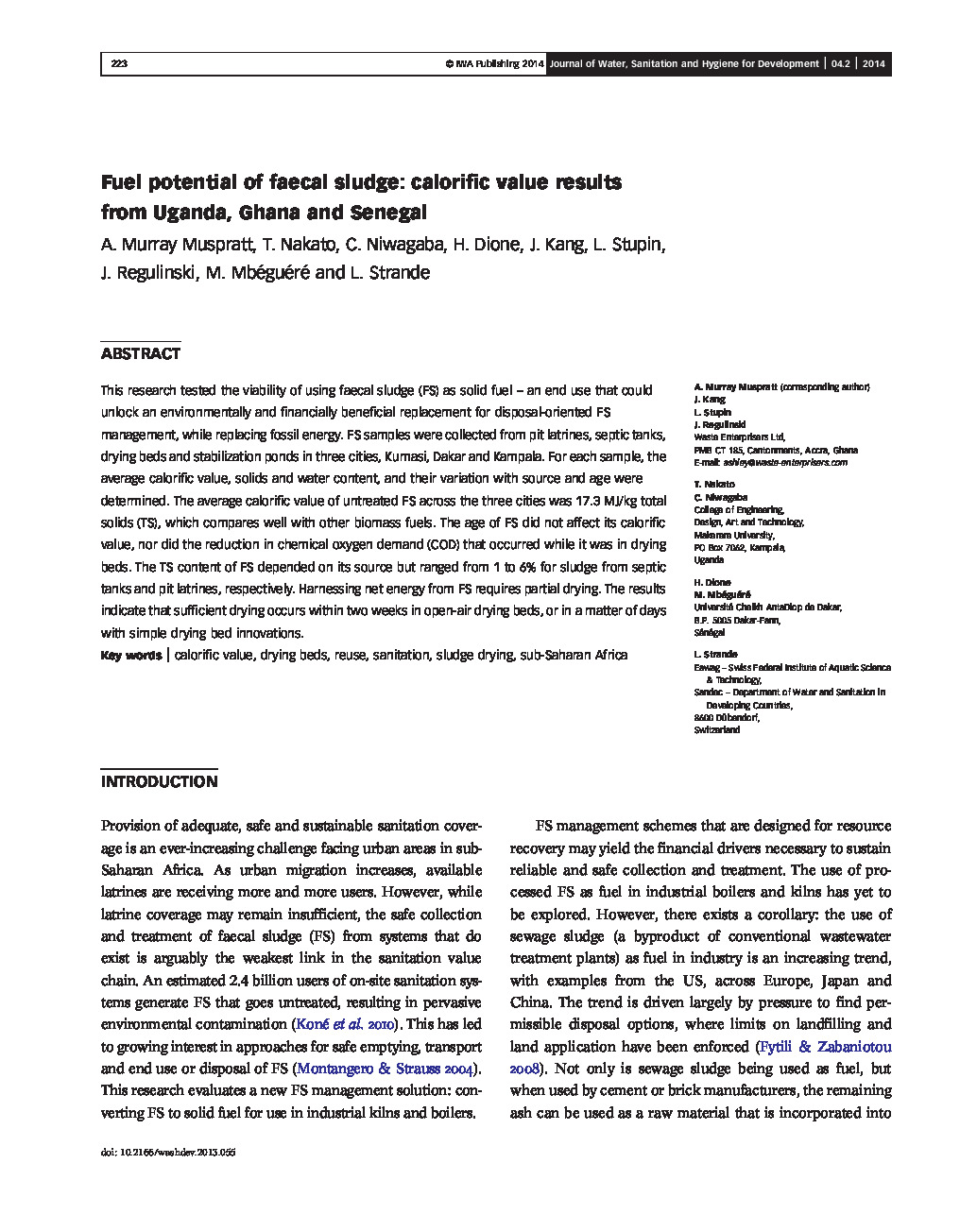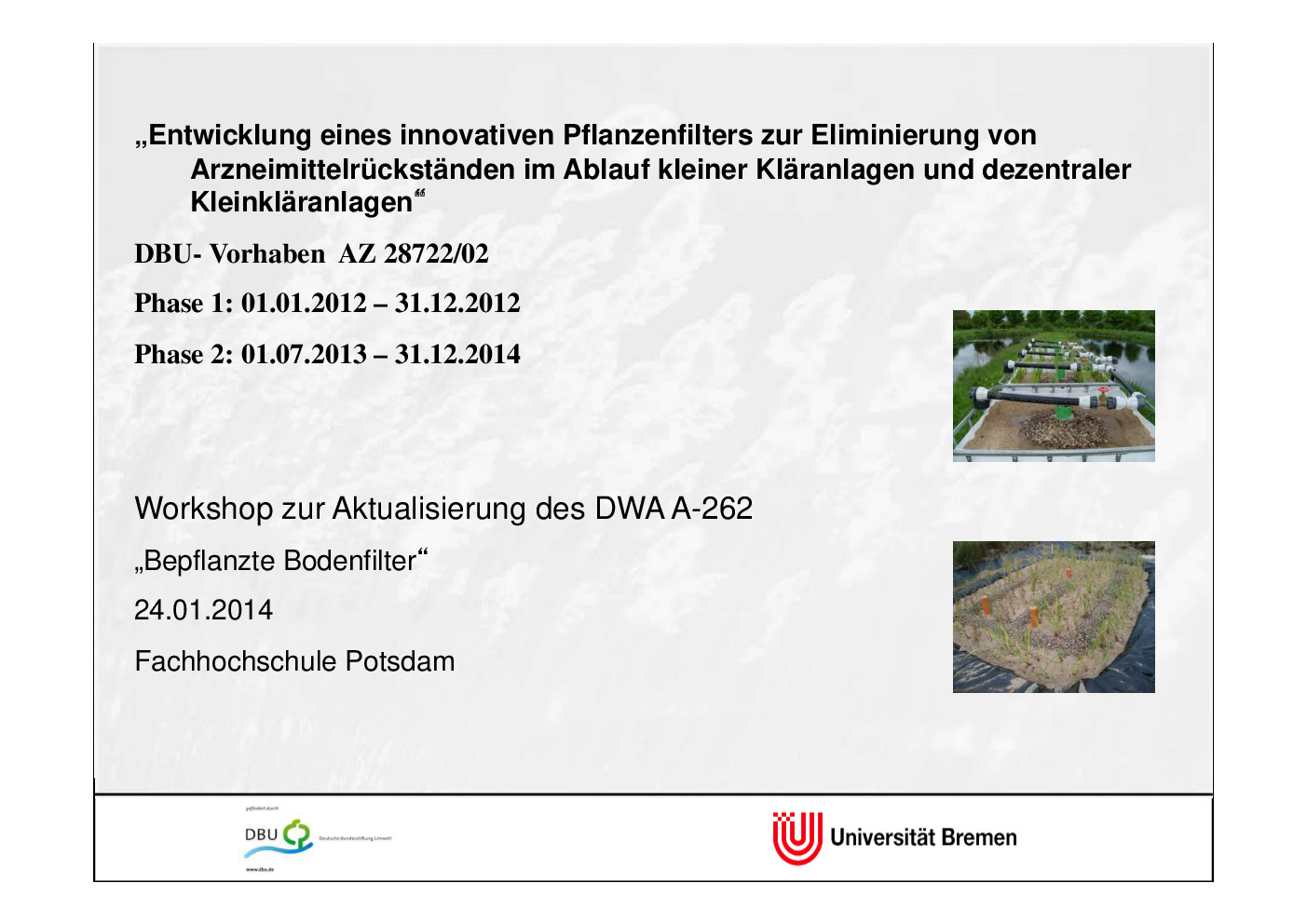-
Containment Collection and transport Treatment Disposal / Reuse
-
Capacity building Finance Information Education and Communication / Behavior Change Communication Infrastructure Policy and processes Technology
-
Access to sanitary toilets Better governance and planning Change in disease burden Collection efficiency of sanitation system Cost recovery Environmental sustainability through reuse, resource recovery, conservation Equity and social inclusion Private sector engagement Quantity of waste safely treated Sanitation practices of the supply side Sanitation practices of the end user
-
Pivot Plant: Converting human waste to fuel to finance complete sanitation - Various documents on results from research grant
This library entry contains background documents for a grant that Ashley Muspratt is leading and which is funded by the Bill and Melinda Gates Foundation.Further information and a discussion is available on the SuSanA discussion forum, see link below.Short description of the project: Pivot is building our first fecal sludge to solid fuel facility (called Pivot Works) that will act as a commercial-scale demonstration factory. When successful, this sanitation process and business model will dramatically lower the barrier to delivering complete sanitation in low-income urban areas of developing countries by generating a viable revenue stream from the sale of fecal sludge-derived by-products.Goal(s): Build a facility in Mombasa, Kenya with an initial capacity of 5 tonnes Pivot Fuel per daySignificantly de-risk the project and unleash commercial capital to take the plant to its full-scale of 40 tonnes Pivot Fuel per dayLeverage this demonstration plant to generate a pipeline of expansion opportunities, furthering the vision of radically improving public and environmental health in cities across sub-Saharan Africa and beyond.This project is also related to the FaME project - www.sandec.ch/fame+++++++++++Documents available for download below:1 - Fuel potential of faecal sludge: calorific value results from Uganda, Ghana and Senegal - Journal paper, 2014(this is a paper in the Journal of Water, Sanitation and Hygiene for Development, 04.2, 2014 and is provided as an open access Version)2 - Maximizing sludge sourcing from low income communities (presentation at FSM3 Conference in Hanoi, Vietnam, Jan. 2015) (by Rachel Sklar)
-
Pivot Plant: Converting human waste to fuel to finance complete sanitation - Various documents on results from research grant
This library entry contains background documents for a grant that Ashley Muspratt is leading and which is funded by the Bill and Melinda Gates Foundation.Further information and a discussion is available on the SuSanA discussion forum, see link below.Short description of the project: Pivot is building our first fecal sludge to solid fuel facility (called Pivot Works) that will act as a commercial-scale demonstration factory. When successful, this sanitation process and business model will dramatically lower the barrier to delivering complete sanitation in low-income urban areas of developing countries by generating a viable revenue stream from the sale of fecal sludge-derived by-products.Goal(s): Build a facility in Mombasa, Kenya with an initial capacity of 5 tonnes Pivot Fuel per daySignificantly de-risk the project and unleash commercial capital to take the plant to its full-scale of 40 tonnes Pivot Fuel per dayLeverage this demonstration plant to generate a pipeline of expansion opportunities, furthering the vision of radically improving public and environmental health in cities across sub-Saharan Africa and beyond.This project is also related to the FaME project - www.sandec.ch/fame+++++++++++Documents available for download below:1 - Fuel potential of faecal sludge: calorific value results from Uganda, Ghana and Senegal - Journal paper, 2014(this is a paper in the Journal of Water, Sanitation and Hygiene for Development, 04.2, 2014 and is provided as an open access Version)2 - Maximizing sludge sourcing from low income communities (presentation at FSM3 Conference in Hanoi, Vietnam, Jan. 2015) (by Rachel Sklar)
-
Processing of human faeces by wet vermifiltration for improved on-site sanitation
The use of a vermifilter containing Eisenia fetida to degrade human faeces in a continuous wet system was explored. This paper aimed to understand the formation of vermicompost within the system, the quality of the effluent produced, and the effect of different bedding matrices. Eight filters were constructed, utilising four different bedding materials: four of these systems were seeded with 400 g of worms (vermifilters) while the others served as controls. The systems were flushed with 12 litres of water per day and the experiment was split into five phases, each with different feeding regimes. Between 23.7 and 24.7 kg of fresh human faecal matter was added to the vermifilters over the 360 day period. The presence of the worms was found to increase the faecal reduction to 96% in the vermifilters on average, compared to 38% in control systems on average. Statistically significant reductions in phosphate, COD and thermotolerant coliforms were achieved in the effluent of all vermifilters. The most suitable bedding matrix was a mixture of coir and woodchip. This study shows that there is potential for continuous treatment of human faeces using wet, onsite vermifilters.
-
Reinvent the Toilet Challenge, Delhi, India - Program and Technical Guides
Featuring partners of key Government ofIndia ministries, and the Bill & Melinda GatesFoundation, the fair showcased innovativeproducts and approaches that aim to bringsafe, affordable, and sustainable sanitationto those who need it most. These includeefforts to create toilets that are not connectedto water, sewer, or electricity; to improvethe collection, treatment, and disposal ofhuman waste; to address behavior change;and to raise awareness of this critical issuefor governments, stakeholders, and localcommunities.This year’s fair in New Delhi was co-hostedby the Government of India’s Department ofBiotechnology and the Bill & Melinda GatesFoundation, with the support of India’s Ministryof Housing and Urban Poverty Alleviation,Ministry of Urban Development, and Ministryof Drinking Water and Sanitation. India isuniquely positioned to be a global leader in thedevelopment of new sanitation technologiesand a range of other innovative approaches toachieve sustainable gains in sanitation in Indiaand abroad.++++++++++++++The following projects are included in the Technical Guides with 2-page factsheets:5 Aerosan7 American Standard Brands8 Arghyam11 Asian Institute of Technology13 Beijing SunnyBreeze Technology Inc.15 Biofilcom17 California Institute of Technology (Caltech)19 Centre for Advocacy and Research (CFAR)21 Centre for Environmental Planning and Technology (CEPT) University23 Center for Study of Science, Technology and Policy (CSTEP)25 Centre for Policy Research, New Delhi27 Climate Foundation, Cornell University, Sanergy, Tide Technocrats, and the Prasino Group29 Cranfield University - Nano-Membrane Toilet31 Defence Research Laboratory, DRDO, Indian Ministry of Defence33 Delft University of Technology35 Department of Industrial Design, SPA Delhi37 Duke University39 Duke University and the University of Missouri41 Eawag (Swiss Federal Institute of Aquatic Science and Technology), Design by EOOS - Blue Diversion43 Eram Scientific Solutions Pvt. Ltd. - eToilet45 FSOI Development Firms: AGI Engineering, Beaumont Design, DCI Automation, and Synapse Product Development - Omni-Ingestor47 Fundación In Terris and Critical Practices LLC - Earth Auger Toilet49 Indian Institute of Technology Kanpur51 Institute for Financial Management and Research (IFMR) and Quicksand Design Studio53 IRC International Water and Sanitation Centre55 Janicki Industries57 Loowatt59 Loughborough University61 National University of Singapore (NUS)63 North Carolina State University - The Excravator65 Pollution Research Group, University of KwaZulu-Natal; eThekwini Water and Sanitation, eThekwini Municipality67 Population Services International (PSI), Water For People, and PATH69 RTI International71 Sanergy73 Santec77 SCOPE75 Sesame Workshop79 Stone India Limited81 Sulabh International Social Service Organisation (SISSO); Sulabh Sanitation & Social Reform Movement83 UNICEF India85 Unilever87 University College London and ifak89 University of Colorado Boulder - Sol-Char toilet91 University of Toronto93 University of the West of England (UWE), Bristol - Urine-tricity (electricity from urine)95 WASH United and World Toilet Organization97 World Bank Water and Sanitation Program, International Finance Corporation, and Kenyan Ministry of Health99 3S – A Division of Saraplast Pvt. Ltd.
-
Reinvent the Toilet Challenge, Delhi, India - Program and Technical Guides
Featuring partners of key Government ofIndia ministries, and the Bill & Melinda GatesFoundation, the fair showcased innovativeproducts and approaches that aim to bringsafe, affordable, and sustainable sanitationto those who need it most. These includeefforts to create toilets that are not connectedto water, sewer, or electricity; to improvethe collection, treatment, and disposal ofhuman waste; to address behavior change;and to raise awareness of this critical issuefor governments, stakeholders, and localcommunities.This year’s fair in New Delhi was co-hostedby the Government of India’s Department ofBiotechnology and the Bill & Melinda GatesFoundation, with the support of India’s Ministryof Housing and Urban Poverty Alleviation,Ministry of Urban Development, and Ministryof Drinking Water and Sanitation. India isuniquely positioned to be a global leader in thedevelopment of new sanitation technologiesand a range of other innovative approaches toachieve sustainable gains in sanitation in Indiaand abroad.++++++++++++++The following projects are included in the Technical Guides with 2-page factsheets:5 Aerosan7 American Standard Brands8 Arghyam11 Asian Institute of Technology13 Beijing SunnyBreeze Technology Inc.15 Biofilcom17 California Institute of Technology (Caltech)19 Centre for Advocacy and Research (CFAR)21 Centre for Environmental Planning and Technology (CEPT) University23 Center for Study of Science, Technology and Policy (CSTEP)25 Centre for Policy Research, New Delhi27 Climate Foundation, Cornell University, Sanergy, Tide Technocrats, and the Prasino Group29 Cranfield University - Nano-Membrane Toilet31 Defence Research Laboratory, DRDO, Indian Ministry of Defence33 Delft University of Technology35 Department of Industrial Design, SPA Delhi37 Duke University39 Duke University and the University of Missouri41 Eawag (Swiss Federal Institute of Aquatic Science and Technology), Design by EOOS - Blue Diversion43 Eram Scientific Solutions Pvt. Ltd. - eToilet45 FSOI Development Firms: AGI Engineering, Beaumont Design, DCI Automation, and Synapse Product Development - Omni-Ingestor47 Fundación In Terris and Critical Practices LLC - Earth Auger Toilet49 Indian Institute of Technology Kanpur51 Institute for Financial Management and Research (IFMR) and Quicksand Design Studio53 IRC International Water and Sanitation Centre55 Janicki Industries57 Loowatt59 Loughborough University61 National University of Singapore (NUS)63 North Carolina State University - The Excravator65 Pollution Research Group, University of KwaZulu-Natal; eThekwini Water and Sanitation, eThekwini Municipality67 Population Services International (PSI), Water For People, and PATH69 RTI International71 Sanergy73 Santec77 SCOPE75 Sesame Workshop79 Stone India Limited81 Sulabh International Social Service Organisation (SISSO); Sulabh Sanitation & Social Reform Movement83 UNICEF India85 Unilever87 University College London and ifak89 University of Colorado Boulder - Sol-Char toilet91 University of Toronto93 University of the West of England (UWE), Bristol - Urine-tricity (electricity from urine)95 WASH United and World Toilet Organization97 World Bank Water and Sanitation Program, International Finance Corporation, and Kenyan Ministry of Health99 3S – A Division of Saraplast Pvt. Ltd.
-
Sanitation Matters - A magazine for Southern Africa - Issue 6 - 2014
Sanitation Matters is a knowledge sharing publication of the Southern Africa knowledge node on sustainable sanitation (SAKNNS).The purpose of the publication is to share information and knowledge on sustainable sanitation within the Southern Africa region.From the table of content:THE SANITATION TECHNOLOGY DEMONSTRATION PROGRAMTHE SPLASH URBAN SANITATION RESEARCH PROGRAMME WORKSHOPIN KAMPALA, UGANDAINDUSTRIAL USE OF FAECAL SLUDGE FOR FUEL:PILOT STUDY IN KAMPALASANITATION COMMUNITY OF PRACTICE WORKSHOP:WISA BIENNIAL CONFERENCE 2014FROM RESEARCH TO PRACTICE:THE LOW FLUSH TOILET FOR ANAL WIPERS:HOW DID WE GET HERE AND WHERE TO FROM NOW?IS ENTRENCHING OF FAECAL AND SEWERAGE SLUDGE A VIABLE OPTION FOR DISPOSAL?RESULTS FROM WRC RESEARCH PROJECT K5/2097IN THE SPOTLIGHT:WATER FOR PEOPLE UGANDASNAPSHOT: RECENT HIGHLIGHTS FROM THE SRFA PROJECT
-
Sanitising faecal sludge with ammonia (from urea) in the context of emergency situations - Master thesis
In an emergency situation, the collection, treatment and disposal of the human excreta and waste in a safe way is one of the biggest challenges to face, regardless the type of disaster. When it comes to faecal sludge management, the traditional desludging methods can often not be appropriate in an acute emergency phase. Consequently, relief organisations aim to apply new and simple approaches and modular technologies that are effective in terms of cost and time.For this thesis the ammonia-based sanitation by the addition of urea was studied as an innovative approach for faecal sludge treatment. The research was designed to assess the required conditions and factors affecting the formation of the sanitising agent ammonia (NH3).This report is on the treatment of faecal sludge in emergency situations on the request of WASTE Advisers as part of the Emergency Sanitation Project (ESP) and the S(P ) EEDKITS Project. The ESP project is funded by the US Office for Foreign Disaster Assistance (OFDA) and is a consortium of the International Federation of Red Cross and Red Crescent Societies (IFRC), WASTE and Oxfam GB. S(P )EEDKITS has received funding from the European Union seventh Framework Programme (FP7/2007-2013) under grant agreement No 284931.
-
Sanitizing Faecal Sludge using Lactic Acid Bacteria in Emergencies
Providing safe excreta collection and disposal in emergency situations has remained one of the most urgent priorities in the disaster relief effort. This is because of the high risk to human health that exposed and unsanitized human excreta pose. With an increase in the frequency and intensity of natural disasters in recent years, humanitarian aid and related organisations worldwide are currently exploring sustainable low cost sanitation technologies and methods that promote safe excreta collection and disposal in disaster and emergency situations.The objective of the research was to evaluate the sanitizing effect of lactic acid and other metabolites produced by Lactic Acid Bacteria (LABs) on human excreta by exploiting and promoting the Lactic Acid Fermentation (LAF) process. The research further explored the pre-conditions required (such as sugar and inoculum concentrations) and the suitability of Yakult, a probiotic milk product, being used as the microbial inoculant to the treatment process. Molasses was selected and used as the sugar additive for the promotion of the LAF process and Escherichia coli as the indicator organism.
-
Sludge treatment
In Issue 21 of SSP we present three papers on „Sludge treatment“, i.e. presented:• In the first paper we describe the new sludge treatment line that is currently implemented at the Vienna mainwastewater treatment plant (the contribution summarises public available material),• Markus Lechner describes the design of the first sludge drying reed bed in Montenegro, and• Magdalena Bäuerl et al. present results of the project FaME on resource recovery from faecal sludge in Sub-Saharan AfricaArticles: Energy Optimisation Sludge treatment (EOS) at the Vienna main wastewater treatment plant- Authors: Günter Langergraber and Norbert WeissenbacherSludge treatment for sewage sludge of an activated sludge wastewater treatment plant in Montenegro using sludge drying reed beds- Author: Markus LechnerFinancing Sanitation: Resource Recovery from Faecal Sludge in Sub-Saharan Africa- Authors: Magdalena Bäuerl, Martin Edthofer, Marie-Alix Prat, Sophie Trémolet and Manfred Watzal
-
Sludge Treatment Wetland (STW) as a Post-Treatment for Toilet-Linked Biogas Plant - A pilot-scale case study in Gujarat, India
Since 1900s, anaerobic biogas digester had been applied successfully in Asian countries like India, Nepal and China, treating cow manure, pig excreta, organic waste or a combination of them, providing not only biogas, which is used as source of energy, but also slurry used as soil conditioner.During last 20 years in India, different government and private institutions promoted the use of toilet linked biogas plants (TLBPs) especially in rural area. TLBP is a modification of the household-size anaerobic biogas digester which includes toilet effluent connection through a pipeline. This system not only generates biogas and slurry, but also offers a new option for wastewater disposal and treatment. However, little is known about the slurrys properties, and previous research studies recommended a post-treatment of TLBPs effluent, prior its use as soil amendment. One of the options are sludge treatment wetlands (STWs).This research characterized the TLBPs effluent by determining its physico-chemical properties and microbiological quality; and also, evaluated the performance of four pilot-scale STWs operated at different sludge loading rates (40.5, 81.0, 121.5 and 162.0 kgTSS/m2-year). After sludge treatment two main products are generated: the biosolid accumulated at the STWs top layer and the water leachate collected at the bottom layer. Both products were evaluated from a reuse in agriculture point of view. Additionally the potential biomass production was compared for two plant species, Phragmites karka and Napier Bajra hybrid grass.The four sludge treatment wetland configurations showed similar efficiencies in terms of nutrients concentration, mineralization and hygienisation, but regarding to sludge dryness, significant differences were observed at different loading rates. In fact, a loading rate of 108 kgTSS/m2-year is recommended to obtain a product with appropriate moisture content. On the other hand, the water leachate collected at the bottom of STWs has a quality enough to comply with the standard limits for reuse in agriculture; it can be reused for irrigation.The TLBP is a very good on-site sanitation example, applicable especially in rural area of India. If a STW is implemented as slurrys post-treatment, not only the slurrys quality is improved, but also treated water if produced, has a potential reuse for irrigation. Additionally, the plants used in STW (Phragmites karka and Napier Bajra hybrid grass) could be a good source of foliage for cows and buffalos; however more specific tests have to be conducted in order to evaluate the plants pollutant accumulation.















